What Does ‘Hygge‘ Mean?
The term ‘Hygge’ (pronounced “hoo-gah”) is described as “cozy” and “comfortable;” however, its meaning extends beyond a design aesthetic. It also represents a mood and a lifestyle that focuses on being oneself and finding pleasure, gratitude, simplicity and beauty in all things. It has no exact translation, but it should be considered a philosophy before it’s considered a ‘look.’ At its core, hygge is a state of cultivating happiness, warmth, mindfulness, and health within our ordinary lifestyles. Culturally, it seems to be manifesting in the U.S. as an interior design aesthetic, but the idea of happiness, health, and wellbeing coincide neatly with the idea of “home,” making interior design a logical extension of hygge’s application.
This article will provide 8 Tips for designing a hygge home. It will provide examples of the hygge aesthetic with some of our favorite hygge AirBNBs available today. First let’s give a quick description of what the hygge aesthetic entails.
What is the ‘Hygge’ Aesthetic?
The hygge aesthetic is largely influenced by the Scandinavian landscape of fjords, forests, and mountains with its color palette centered around natural, earthy tones. Design choices could range from gray to pale birch, granite to greens, gold and copper shades to soft pastel. These soft hues make great paint colors for hygge design. The soft color palette is enhanced by soft and cozy blankets, pillows, upholsteries and rugs in these spaces. Ideal fabrics include wools, furs, fleeces, sherpas, shags, and other fluffy fabrics. Candles, coffee mugs, books, fireplaces, and poufs can tie the aesthetic of a hygge room together.
While its design tenet prioritizes function over form, the hygge style is trending with its own sense of fashion. The Scandinavian concept invites designers to establish minimalist, snug, and functional spaces to create a home-y feel. Originating as a Scandinavian concept, inspiration can be found in one of Scandinavia’s biggest cultural influences – the modern cabin.
We’ll look at 8 steps you can take to create hygge spaces in your own home. If you’re wondering “what are examples of hygge?” we’ll be exploring real-life examples of hygge cabins for inspiration.
1. Layer Textiles
Living Room
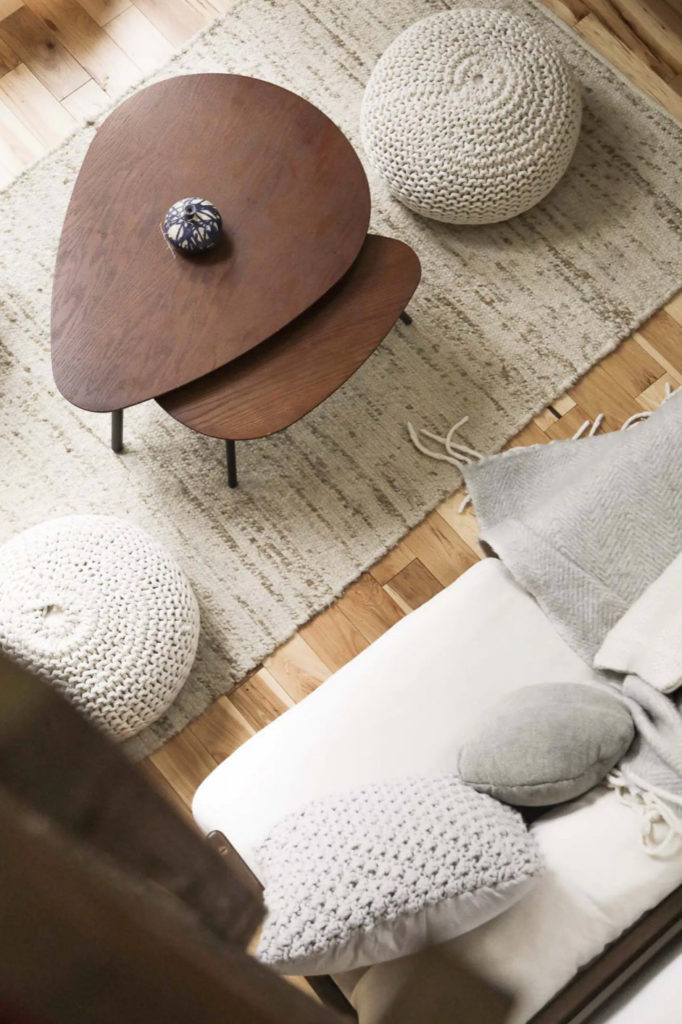
Get rid of your great-aunt Helen’s flower-patterned couch. Replace it with a neutral-colored, linen L-shaped sectional, and make your sofa the center of your cozy hub. Layer it with with faux-fur blankets and throw pillows.
The more pillows the better. Get your design pops from texture and patterns rather than loud colors. This overhead shot of the living room from @cabinvibes is an example of hygge in a cabin you can visit in real life.
You can add pillows or take them off. You can pull over a pouf to rest your feet, or push it away and sit up. If you’re chilly, grab a blanket, if you’re getting too warm from the fireplace, set the blankets aside.
Similar to how you dress in layers in the Fall, you should dress your sofa in layers – it’s one key to creating a comfy, hygge living room.
Bedding
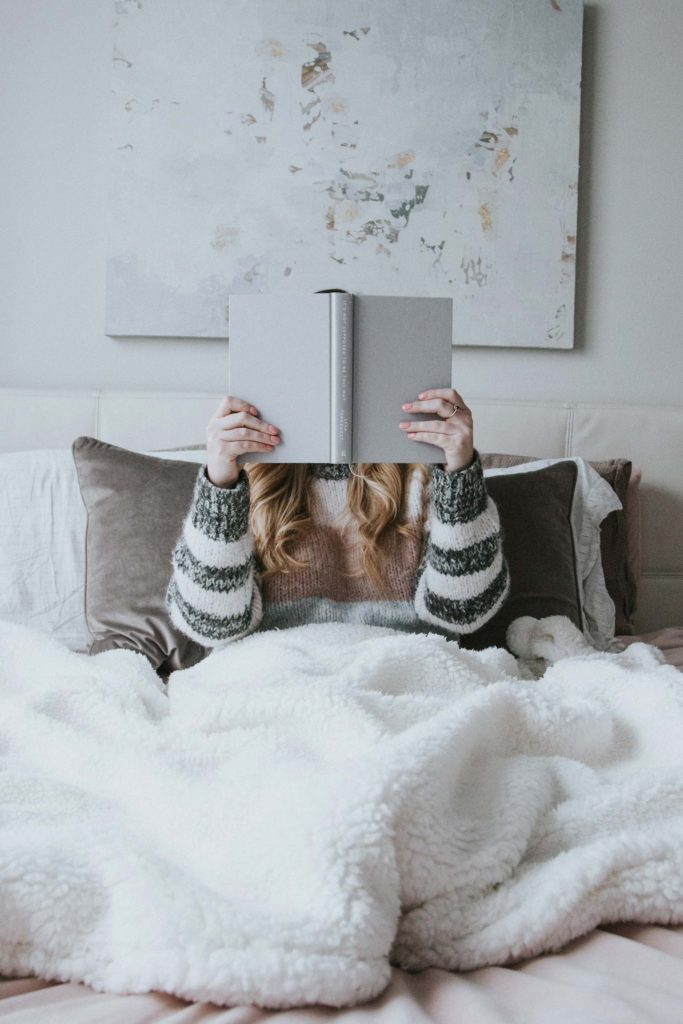
Bedding is another example of hygge style that offers an opportunity to layer fabrics. From sheets to comforters to throw blankets to pillows, the components of your bedding serve purposes beyond sleeping.
When you’re casually laying on the bed, you’ll use the throw blanket and lay on top of the comforter. When you’re going to sleep, you would get under the top sheet and comforter; when it’s warm, you may peel back the comforter; when it’s cold, you may add your lighter blanket on top of the comforter.
Pillows function the same way by starting with your sleep pillows underneath, then shams, and then abundant throw pillows on top. When journaling or reading a book on your bed, you’ll sit up against all of your pillows, when you’re taking a nap you may throw some of the pillows off the bed, and when you’re going to bed, you’ll probably just have the sleep pillows on the bed and all of the extra pillows on the floor. Pillows are one of the best examples of hygge prioritizing function and comfort.
2. Light Candles
Scented candles are one of the most subtle little extravagances of everyday life. The hygge way of life encourages you to savor the little things, and a scented flame is a small design accessory with a lot to offer. The flame itself adds a quieting aura to the space and a trace of warmth that embodies the comfort of the indoors.
Aromas are extremely effective at creating ambiance as smell is strongly connected with emotion. A selection of candle choices provide the ability to change the mood on a day-to-day basis simply by burning a different candle. To go from a cozy winter Christmas vibe one evening to a light refreshing and meditative ambiance the next can be as simple as burning a cinnamon-gingerbread candle one day and a lavender-sage candle the next.
3. Light the Fireplace
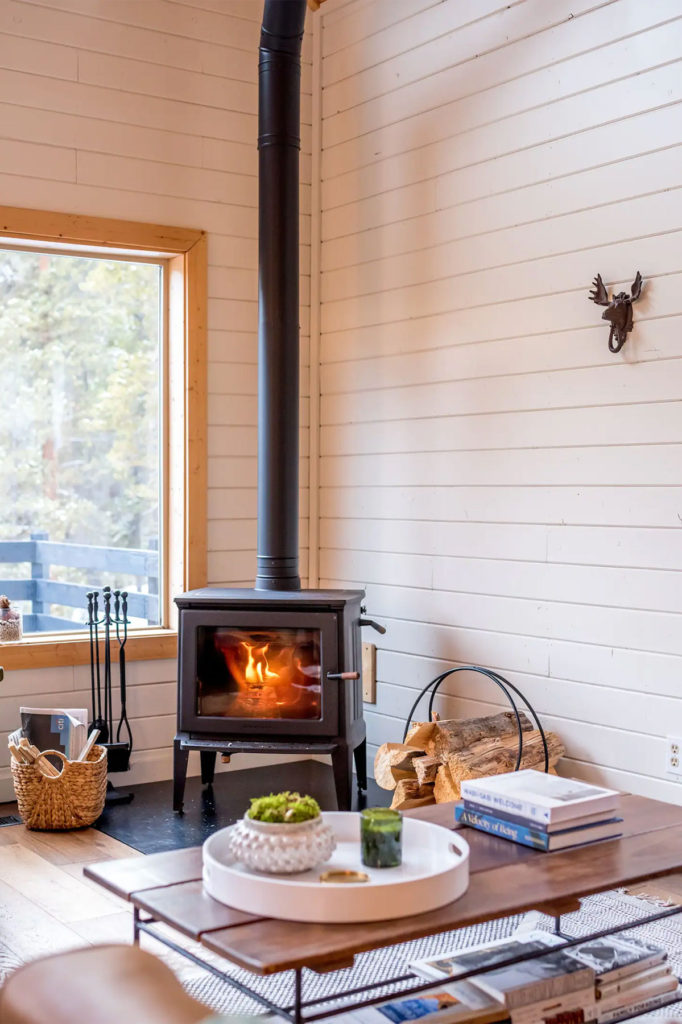
If you’re fortunate to have a functioning fireplace, embrace it. Starting a fire on a cold night is an incredible way of unwinding and resetting. However, built-in fireplaces and chimneys aren’t the only way to bring a fireplace into your home.
There are plug-in electric fireplace options, wood and pellet stoves, and my personal favorite – malm fireplaces which are generally wood or gas fueled. For inspiration, check out the article on my favorite cabin fireplaces here.
The fireplace shown here is from @alpenglowcabin, one of my favorite cabins in Twin Lakes, CO.
4. Use Warm Light
Candles and fireplaces are on the list not only as decorative pieces, but as a light sources as well. Lighting is one of the most important ways of creating a mood – whether that’s dark and dreary on a rainy day, bright and sterile in a doctors office, or cozy and comfortable in your candle-lit home. However, you’re not going to be living off of candle light alone, so here are general lighting guidelines:
With any light fixture you choose, think about the corresponding bulb. You’ll notice that they’re classified according to their temperatures and have names like “warm white,” “natural white,” and “cool white.” Stay away from cool tones and fluorescents – they feel corporate and institutional. Instead, opt for warm, cozy, and perhaps even dim tones.
Bistro lights are a great way to achieve a lounge-like atmosphere. Peppering lamps throughout your spaces is a great way to create a cozy vibe and also give you the power to add or subtract light depending on the situation.
Overpowering, overhead lighting is the easiest way to kill the hygge vibe. Again, use warm tones, and put your main light sources on dimmer switches so you’re in control.
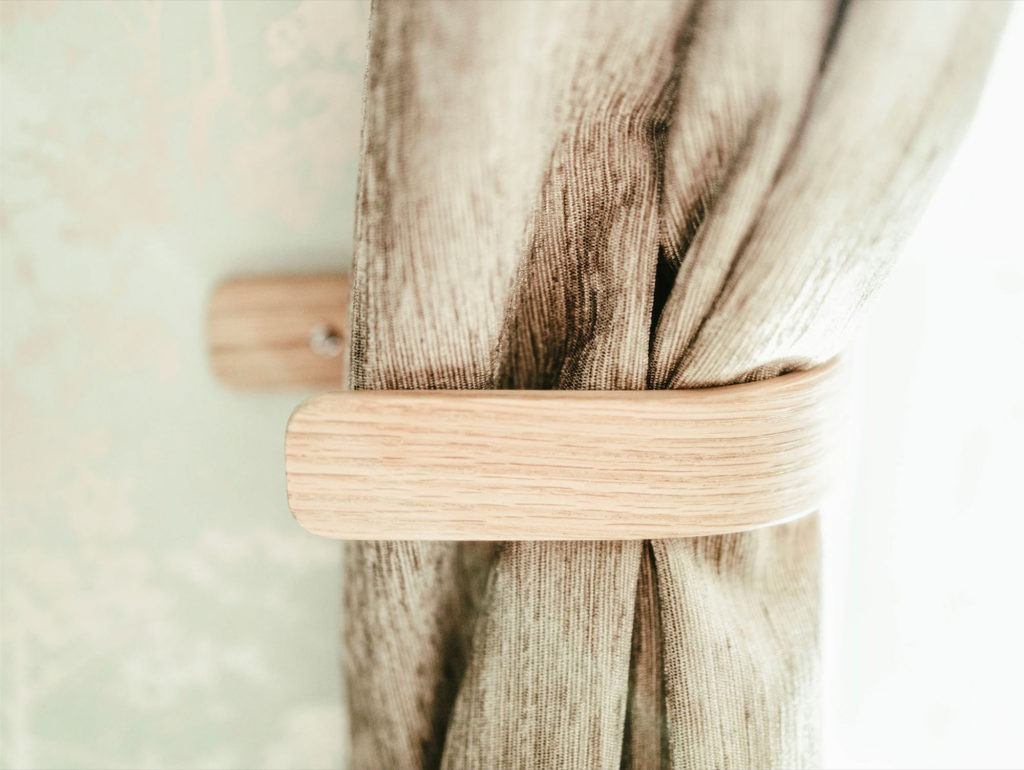 As previously mentioned, the hygge style is rooted in natural elements and earth tones, so natural light is going to be another great option. Let in lots of natural light by using sheer curtains rather than dark, blackout curtains. Or use your darker tones but keep your curtains open with these natural wood holdbacks. This is an example of hygge design that focuses on function over form.
As previously mentioned, the hygge style is rooted in natural elements and earth tones, so natural light is going to be another great option. Let in lots of natural light by using sheer curtains rather than dark, blackout curtains. Or use your darker tones but keep your curtains open with these natural wood holdbacks. This is an example of hygge design that focuses on function over form.
5. Choosing Paint Colors
We’ve already discussed examples of hygge colors, but I’ve also handpicked a few commercial colors I like for hygge spaces – they’re all subtle, earth tones. Sherwin Williams also offers a palette of natural neutral colors, you can use to give your space a touch of hygge. Here are a few examples of hygge paints you can find in Home Depot:
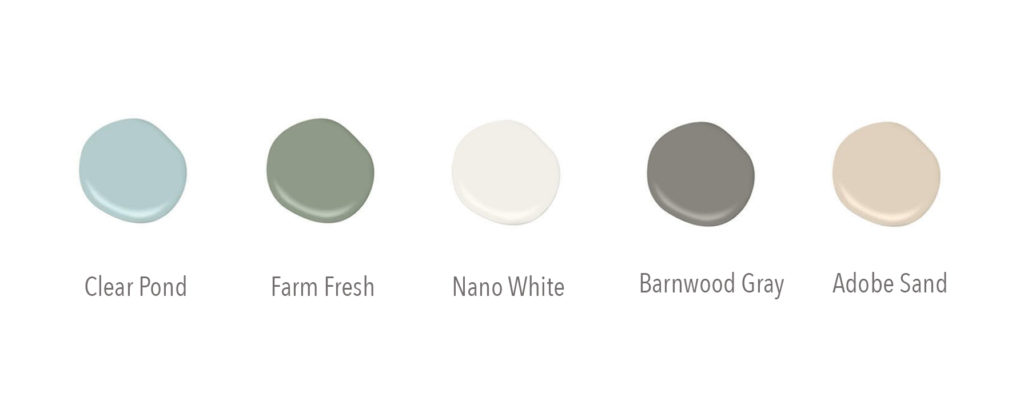
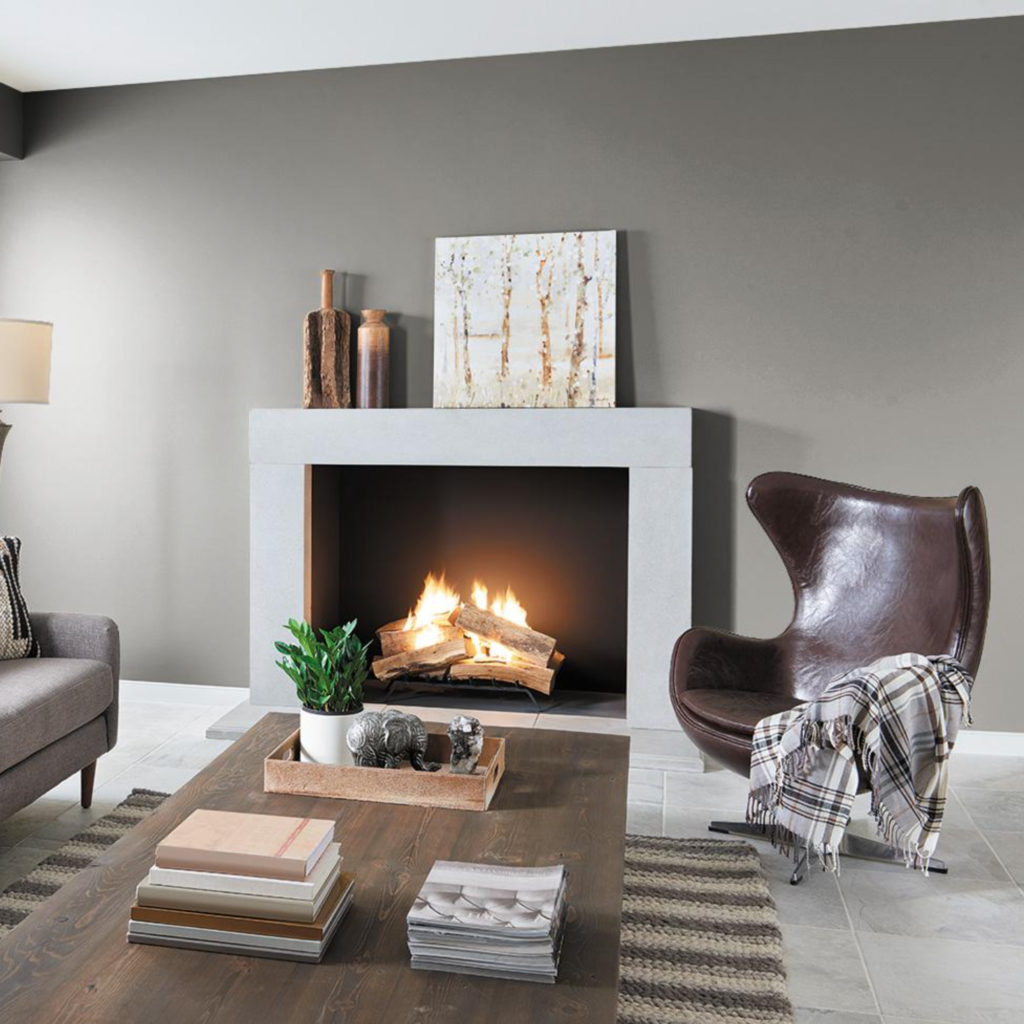
The Adobe Sand and Nano White options are great examples of hygge neutral tones for large spaces. I prefer the Clear Pond, Farm Fresh, and Barnwood Gray for accents. Barnwood Gray, in particular, is fairly dark to be a 4-wall color, though not impossible. I love the way it’s used here:
6. Build in cozy nooks
Cozy reading areas, chase lounges, bean bag chairs and bookshelves can be used to create little nooks. In an age of open floor plans, the cozy vibes of small rooms and enclosed spaces are often lost. Position your furniture and design spaces to isolate themselves into their own comfy nooks. Lining these areas with pillows, rugs, poufs, and bean bags is an affordable way to avoid furniture and achieve the hygge look.
7. Eliminate clutter
There’s nothing wrong with filling wall space, but adding “stuff” for the sake of design is not the foundation of hygge as a lifestyle nor as an aesthetic. Don’t overcrowd your rooms and shelves with trinkets and decor. There is a minimalist element entrenched in hygge’s meaning.
An easy way to decorate is to design with things you need and use first. Rather than buying knick-knacks, line your shelves with books. Rather than buying canvases and wall signs at Home Goods, hang photographs you love and artwork that inspires you. Rather than putting pottery on your sideboard, consider leaving your favorite vinyl albums out on display.
If you design with the things you use and love, you’ll likely find that you’re not lacking for “things.” It’s also a cheaper way to design! Once you’ve finished displaying things that matter to you, only then consider buying decor. I personally like to fill in the gaps with potted plants because they bring literal life to the room. Design mindfully; add things that make you happy.
8. Personalize
Remember that more than anything else, hygge is a mindset and lifestyle of comfort, simplicity, and well-being – hygge design is just a physical manifestation of those same concepts. When you’re designing a hygge space, the most important design tool is your own set of emotions.
Bring nostalgia into your home with items that evoke fond memories of your childhood. Frame photos of loved ones and find a dresser to display heartfelt letters from friends. Keep positive thoughts circulating in your head and in your home with inspirational books on your shelves and powerful albums beside your record player. Rather than filling your walls simply to decorate, display the things that make you feel something. Create a space that helps you to relax or inspires your own creativity. Create a space that makes you feel loved and nurtured. Create a space that makes it easier to live the lifestyle you want to embody.
Where can I find more examples of hygge?
For more real-life hygge AirBNBs and VRBOs that you can stay at for yourself (or steal design inspiration from), check out my instagram page @stiksandbriks.
